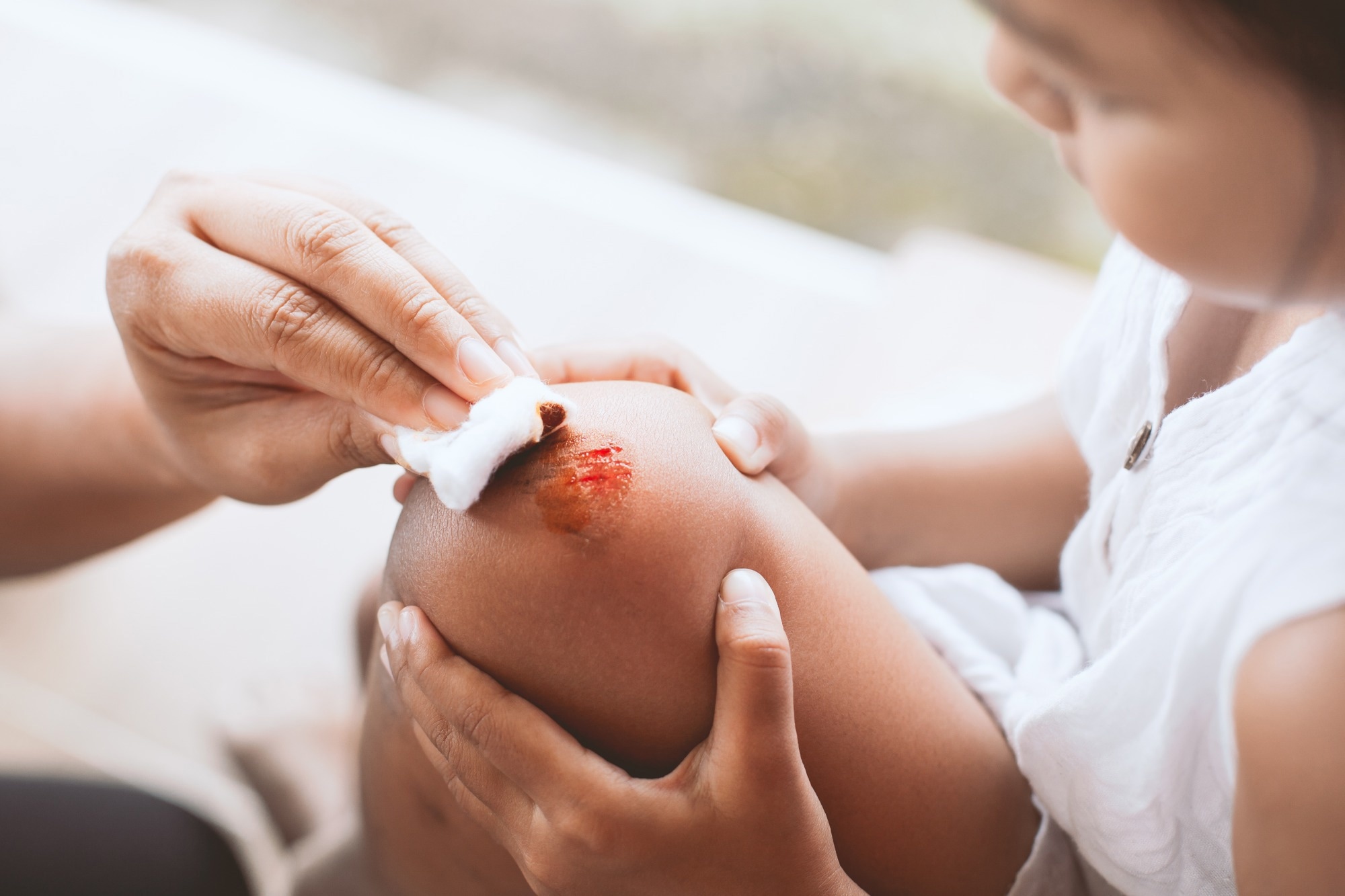In a recent Nature Reviews Microbiology study, researchers review how the wound microbiota interferes with skin repair processes and facilitates infection onset by modulating host immune responses.
 Study: The wound microbiota: microbial mechanisms of impaired wound healing and infection. Image Credit: A3pfamily / Shutterstock.com
Study: The wound microbiota: microbial mechanisms of impaired wound healing and infection. Image Credit: A3pfamily / Shutterstock.com
Background
The skin protects the human body from the potentially harmful effects of invading pathogens and chemicals. Any injury or damage to the skin can lead to wound development; therefore, dressing and infection control are standard practices of wound care.
The wound-healing process involves coagulation, hemostasis, inflammation, cell proliferation and migration, and tissue remodeling. Any alteration to these processes can lead to delayed wound healing and the development of a chronic wound.
Non-healing and chronic wounds are associated with certain risk factors, including advanced age and the presence of specific comorbidities, such as diabetes, obesity, systemic diseases, immunosuppressive diseases, and autoimmune diseases.
Microorganisms colonizing in wounds, collectively referred to as the wound microbiota, can significantly impact the healing process. While some microorganisms facilitate faster skin repair, some can acquire virulence factors and antibiotic resistance, thereby increasing the risk of infection.
Both exogenous and endogenous microorganisms can contaminate an open wound. The wound can facilitate microbial growth by exposing subcutaneous tissues and nutrients, which can subsequently lead to the colonization of microorganisms in the wound. This type of colonization can cause local infection and biofilm formation, which has the potential to spread to other tissues and organs.
Wound microbiota composition
The most common microbial populations found in both acute and chronic wounds include Staphylococcus spp., Pseudomonas spp., Corynebacterium spp., Enterococcus spp., Streptococcus spp. and Cutibacterium spp, all of which are microorganisms that are also commonly found in healthy skin microbiota.
Staphylococcus aureus
A skin wound can significantly alter its surrounding environment through the secretion of molecules from damaged tissues to support the growth, invasion, adhesion, and migration of pathogens such as Staphylococcus aureus. High abundance of fibronectin- and collagen-binding proteins facilitates Staphylococcus aureus to easily invade broken skin and induce intracellular infection.
Staphylococcus aureus also produces pore-forming toxins that disrupt the host cell membrane to prevent immune clearance. Furthermore, serine proteases produced by this bacterium act as enterotoxins that induce chronic inflammation and create severe, non-healing diabetic wounds.
Staphylococcus aureus has multiple master regulators, including the accessory gene regulator quorum-sensing system and sarA, which help activate its virulence factors. Glucose transporters acquired by Staphylococcus aureus further induce the production of virulence factors under hyperglycemic conditions.
Pseudomonas aeruginosa
Pseudomonas aeruginosa is a pathogen that can be found in burn wounds, chronic surgical wounds, and diabetic wounds. High-level antibiotic resistance and robust ability to form biofilm allow Pseudomonas aeruginosa to create chronic and non-healing wounds. Pseudomonas aeruginosa also comprises a type III secretion system that controls the production of effector toxins, further facilitating the production of virulence factors.
Streptococcus
Streptococcus spp., including β-Hemolytic group A streptococci (GAS), group B streptococci (GBS), and group C streptococci, can be found in invasive and non-invasive wounds.
GAS bacteria contain multiple adhesins that promote their access to diverse tissue surfaces. Virulence factors present in GAS bacteria work in synergy to bind to and activate host plasminogens and create a proteolytic environment that alters wound-site architecture.
Anaerobic bacteria
Anaerobic bacteria commonly found in wound infections include Finegoldia magna, B. fragilis, and Clostridium perfringens. These bacteria can be introduced to the wound during injury, such as bite or abdominal penetrating wounds. In diabetic or other chronic wounds, these bacteria thrive in conditions of low tissue oxygenation and can exist in mixed facultative and obligate anaerobes communities.
Fungi
Candida albicans is a fungal species most commonly found in chronic, surgical, and burn wounds. These fungi can enter host cells by binding to E-cadherin and triggering endocytosis. The pathogenicity of C. albicans is dependent on its ability to switch between yeast and a highly invasive hyphal phenotype.
Viruses
Viruses can also impact wound healing and skin repair processes. Whereas specific bacteriophages can worsen wound infections by increasing the virulence of bacteria they have infected, other bacteriophages can improve wound healing by changing bacterial virulence.
Risk factors for wound infection
The outcomes of wound microbial infections primarily depend on microbial virulence, polymicrobial interactions, and complex crosstalk between microbes and the wound microenvironment.
Multidrug-resistant pathogens, including methicillin-resistant Staphylococcus aureus (MRSA) or multidrug-resistant Pseudomonas aeruginosa, can complicate the treatment of wound infections. Likewise, a compromised immune system or certain genetic factors can further delay the wound-healing process and increase the risk of infection.
Microbial virulence is also an important determinant of wound outcomes and treatment modalities. Wound bioburden, characterized by microbial load, microbial diversity, and the presence of pathogenic microbes, is a key contributor to delayed wound healing and infection onset.
Journal reference:
- Uberoi, A., McCready-Vangi, A., & Grice, E. A. (2024). The wound microbiota: microbial mechanisms of impaired wound healing and infection. Nature Reviews Microbiology. doi:10.1038/s41579-024-01035-z.